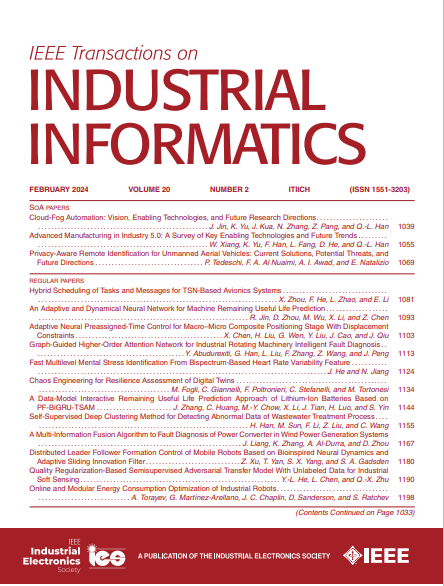Buffer-Aided-Based Resilient State Estimation for Mobile Robot Localization With State Saturation: A Probabilistic-Encoding Case
IF 9.9
1区 计算机科学
Q1 AUTOMATION & CONTROL SYSTEMS
引用次数: 0
Abstract
In this article, the encoding-decoding-based resilient state estimation problem is investigated for the mobile robot localization with state saturation under the buffer-aided mechanism. To reduce the impact of the intermittent measurements on estimation performance, the buffer-aided mechanism is introduced to store the untransmitted measurements when the transmission is impermissible. The unbiased probabilistic encoding–decoding approach is employed to improve the efficiency and security of the transmission. In addition, the state saturation modeled by a signum function is considered for a more accurate depiction of real-world engineering. The main objective of this article is to establish a buffer-aided-based resilient state estimator for the state-saturated mobile robot localization subject to the probabilistic encoding–decoding, such that the minimal upper bound on the estimation error covariance is guaranteed by appropriately designing the desired estimator gain. Finally, the effectiveness of the proposed estimation scheme is evaluated on a mobile robot platform with buffer capacities of基于缓冲辅助的状态饱和移动机器人定位弹性状态估计:一种概率编码情况
在缓冲辅助机制下,研究了具有状态饱和的移动机器人定位的基于编码-解码的弹性状态估计问题。为了减少间歇性测量对估计性能的影响,在不允许传输时引入了缓冲辅助机制来存储未传输的测量。采用无偏概率编解码方法,提高了传输的效率和安全性。此外,为了更准确地描述现实世界的工程,考虑了由sgn函数建模的状态饱和。本文的主要目的是建立基于缓冲辅助的基于概率编解码的状态饱和移动机器人定位弹性状态估计器,通过适当设计期望的估计器增益来保证估计误差协方差的最小上界。最后,在缓冲容量为$M= 2,4,6 $的移动机器人平台上对所提估计方案的有效性进行了评估。通过对比分析,讨论了不同编码间隔/增益变化系数对状态估计精度的影响。此外,与扩展卡尔曼滤波相比,所提出的估计方案在计算时间仅增加62.4%的情况下,估计性能有了显著提高。
本文章由计算机程序翻译,如有差异,请以英文原文为准。
求助全文
约1分钟内获得全文
求助全文
来源期刊

IEEE Transactions on Industrial Informatics
工程技术-工程:工业
CiteScore
24.10
自引率
8.90%
发文量
1202
审稿时长
5.1 months
期刊介绍:
The IEEE Transactions on Industrial Informatics is a multidisciplinary journal dedicated to publishing technical papers that connect theory with practical applications of informatics in industrial settings. It focuses on the utilization of information in intelligent, distributed, and agile industrial automation and control systems. The scope includes topics such as knowledge-based and AI-enhanced automation, intelligent computer control systems, flexible and collaborative manufacturing, industrial informatics in software-defined vehicles and robotics, computer vision, industrial cyber-physical and industrial IoT systems, real-time and networked embedded systems, security in industrial processes, industrial communications, systems interoperability, and human-machine interaction.
 求助内容:
求助内容: 应助结果提醒方式:
应助结果提醒方式:


